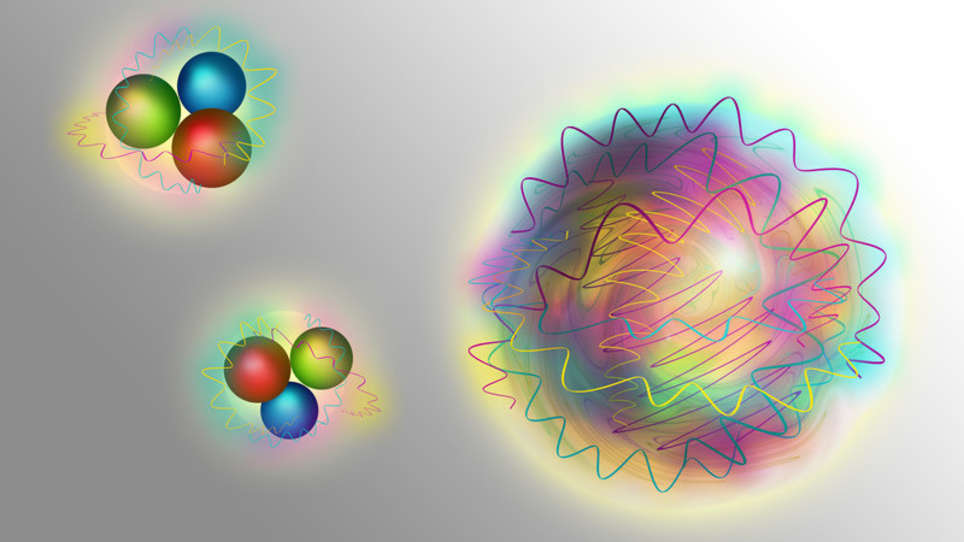Search for new and verification of theoretically predicted nuclear particles is always going on and has been made exciting and fruitful with the advanced experimental facilities developed through international collaboration. The discovery contributes to physicists’ understanding of how all the matter in the universe interacts at the smallest levels. Unlike the famous Higgs boson, which was officially discovered in 2012, the odderon isn’t a particle exactly. Instead, it’s the name for a compound of three gluons that gets exchanged between protons (or a proton and its antimatter twin, the antiproton) when they collide violently but aren’t destroyed.
Gluons are subatomic particles so named because they “glue” together other particles called quarks; quarks are the tiny things that make up the bigger particles like protons and neutrons that form the atoms. Gluons are funny in that they don’t like to be alone; they’re almost always found together. When it’s an even-numbered group of gluons (two, four, etc.), we call it a pomeron. When the number of gluons in the group is odd (three, five, etc.), is called odderon.
The advent of quantum chromodynamics (QCD) led theorists to predict the existence of the odderon, a three-gluon state in 1973. States comprising two, three or more gluons are usually called glueballs, and are peculiar objects made only of the carriers of the strong force. The Odderon particle is what briefly forms when protons collide in high-energy collisions, and in some cases do not shatter, but bounce off one another and scatter. Protons are made up of quarks and gluons, that briefly form Odderon and Pomeron particles. Through extensive data analyzes of elastic proton-proton and proton-antiproton collisions, the researchers were able to hone in on the new particle. The new findings concern hadrons — the family of particle that includes protons and neutrons. Hadrons are formed by quarks “glued” together with gluons. Previously, scientists have observed collisions involving only an even number of gluons exchanged between the protons. In these collisions, protons remain intact after the collision, a process known as elastic scattering. The findings will shed light on the fundamental makeup of all matter in the universe.
Proving the existence of odderon particle has been a major experimental challenge, however, requiring detailed measurements of protons as they glance off one another in high-energy collisions. While most high-energy collisions cause protons to break into their constituent quarks and gluons, roughly 25% are elastic collisions where the protons remain intact but emerge on slightly different paths. While most high-energy collisions cause protons to break into their constituent quarks and gluons, roughly 25% are elastic collisions where the protons remain intact but emerge on slightly different paths (deviating by around a millimetre over a distance of 200 m at the LHC). TOTEM measures these small deviations in proton–proton scattering using two detectors located on either side of the CMS experiment 220 m from the interaction point, while DØ employed a similar setup at the Tevatron proton–antiproton collider. At lower energies, differences in proton–proton vs proton–antiproton scattering are due to the exchange of different virtual mesons – particles made up of a quark and an antiquark. At multi-TeV energies, on the other hand, proton interactions are expected to be mediated purely by gluons. In particular, elastic scattering at low-momentum transfer and high energies has long been explained by the exchange of a pomeron – a “colour-neutral” virtual glueball made up of an even number of gluons.
Now scientists have discovered the mythical particle “odderon” with the help of extensive analysis of experimental data from the Large Hadron Collider at CERN in Switzerland. Physicists from the TOTEM (TOTal cross section, Elastic scattering and diffraction dissociation Measurement) Collaboration at CERN’s Large Hadron Collider (LHC) and the DØ Collaboration at Fermilab have found strong new evidence for the odderon. According to scientists, the result probes the deepest features of quantum chromodynamics, notably that gluons interact between themselves and that an odd number of gluons are able to be ‘colorless,’ thus shielding the strong interaction. A notable feature of this work is that the results are produced by joining the LHC and Tevatron data at different energies. TOTEM measures small deviations in proton-proton (pp) scattering using two detectors located 220 m on either side of the CMS experiment, while DØ employed a similar setup at the Tevatron proton-antiproton (pp?) collider. The physicists compared LHC pp data (recorded at collision energies of 2.76, 7, 8 and 13 TeV and extrapolated to 1.96 TeV), with Tevatron pp? data measured at 1.96 TeV. The odderon would be expected to contribute with different signs to pp and pp? scattering. Supporting this picture, the two data sets disagree at the 3.4σ level, providing evidence for the t-channel exchange of a colorless, C-odd gluonic compound. When combined with the ρ and total cross-section result at 13 TeV, the significance is in the range 5.2-5.7σ and thus constitutes the first experimental observation of the odderon.
While most high-energy collisions cause protons to break into their constituent quarks and gluons, roughly 25% are elastic collisions where the protons remain intact but emerge on slightly different paths (deviating by around a millimetre over a distance of 200 m at the LHC). TOTEM measures these small deviations in proton–proton scattering using two detectors located on either side of the CMS experiment 220 m from the interaction point, while DØ employed a similar setup at the Tevatron proton–antiproton collider. At lower energies, differences in proton–proton vs proton–antiproton scattering are due to the exchange of different virtual mesons – particles made up of a quark and an antiquark. At multi-TeV energies, on the other hand, proton interactions are expected to be mediated purely by gluons. In particular, elastic scattering at low-momentum transfer and high energies has long been explained by the exchange of a pomeron – a “colour-neutral” virtual glueball made up of an even number of gluons.
